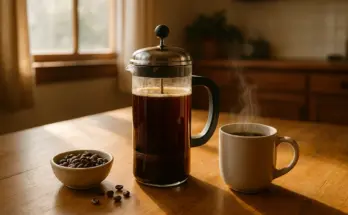There’s something special about a pour-over coffee. It’s not just another brewing method; it’s a small act of mindfulness. Every step, from heating the water to the final pour, invites you to slow down and savor the moment. The result is a cup that’s crisp, clean, and deeply flavorful.
Unlike automatic drip machines, pour-over coffee puts you in charge. You control the water flow, temperature, and timing. That control means you can draw out the subtle notes in your beans, the floral aroma, the hint of fruit, or the chocolate undertone. Each cup becomes a reflection of your choices and care.
Many coffee lovers find that pour-over coffee offers a cleaner taste because it uses a paper filter. This filter traps oils and fine grounds, leaving you with a bright, refreshing brew that highlights the bean’s natural character. It’s the difference between listening to music on a radio and hearing it live, every note comes through clearly.
If you’re new to brewing, don’t worry. You don’t need fancy gear or years of practice. With a few simple tools and the right technique, anyone can master pour-over coffee. In this guide, we’ll walk through the equipment, beans, and exact steps you need to make your best cup yet.
What You’ll Need to Get Started
The beauty of pour-over coffee is that it’s simple and affordable to begin. You only need a few basic tools to create café-quality coffee at home.
Start with a pour-over dripper. Popular options include the Hario V60, Kalita Wave, or Chemex. Each works well, so choose one that fits your style and budget. You’ll also need paper filters designed for your dripper’s shape. These filters are key to achieving that clean, bright flavor.
A gooseneck kettle is worth the investment. Its narrow spout allows for slow, controlled pouring, giving you precision that a regular kettle can’t match. Combine this with a digital scale to measure your coffee and water ratio accurately. Consistency is the secret to great results.
Use a burr grinder instead of a blade grinder. Burr grinders create uniform grounds, which helps water flow evenly through the coffee bed. For pour-over, aim for a medium grind, similar to sea salt.
Finally, use freshly roasted beans and filtered water. Since coffee is over 98% water, using clean water makes a noticeable difference in taste. Optional tools like a timer and thermometer can help you refine your process, but they aren’t essential at first. Once you have these basics, you’re ready to brew.
Choosing the Right Coffee Beans
The flavor of your pour-over coffee begins long before you pour the first drop of water, it starts with your beans. Choosing the right beans is the most important step for a balanced, flavorful cup.
Look for beans that were roasted within the past two to three weeks. Freshness matters because older beans lose aroma and complexity. If possible, buy whole beans and grind them just before brewing to preserve their natural oils and flavors.
For pour-over coffee, medium roast beans are a great choice. They strike a balance between sweetness, acidity, and body. Light roasts can bring out delicate floral or citrus notes, while darker roasts create a heavier, more robust cup. The best choice depends on your taste preference, so experiment with different origins and roast levels.
Single-origin beans often showcase unique regional flavors, Ethiopian coffees tend to be bright and fruity, while Colombian beans are known for smooth, nutty tones. Blend varieties can offer consistency and balance.
Whatever you choose, always store your beans in an airtight container away from light, heat, and moisture. Good coffee begins with good beans, and for pour-over, that quality shines through in every sip.
Step-by-Step: How to Brew Pour-Over Coffee
Brewing pour-over coffee may look fancy, but it’s actually simple once you know the rhythm. This step-by-step guide will walk you through each stage of the process, from grinding your beans to pouring the perfect stream of water, so you can enjoy a clean, flavorful cup every time.
1. Measure and Grind the Coffee
Start by measuring about 25 grams of coffee for 400 grams (or milliliters) of water, a 1:16 ratio. This ratio provides a balanced cup with both body and clarity. Grind your beans to a medium consistency, like coarse sand or sea salt.
If your coffee tastes too bitter, try a coarser grind next time. If it tastes weak or sour, go a little finer. Small adjustments make a big difference.
2. Heat the Water
Heat your water to around 200°F (93°C). If you don’t have a thermometer, bring it to a boil and let it sit for about 30 seconds. Water that’s too hot can scorch the coffee, while cooler water may under-extract it.
3. Prepare the Filter and Dripper
Place the paper filter in your dripper and rinse it thoroughly with hot water. This removes any papery taste and warms your mug or carafe. Discard the rinse water before adding the grounds.
4. Add the Coffee Grounds
Pour your ground coffee into the filter and gently shake or tap the dripper to level the bed. This helps ensure even extraction.
5. The Bloom Phase
Start your timer and pour just enough hot water (about twice the weight of your coffee) to saturate the grounds, around 50 grams for 25 grams of coffee. The coffee will expand and bubble slightly. This is called the bloom, a sign that carbon dioxide is escaping. Let it sit for about 30–45 seconds.
6. The Main Pour
After the bloom, pour in slow, steady circles, keeping the water level consistent. Avoid pouring directly on the filter edges. The goal is to keep the grounds evenly saturated without flooding them.
Continue pouring in small increments until you reach your total water weight. The entire brew should take about 2½ to 3½ minutes.
7. Let It Drain and Serve
Once the water has passed through the grounds, remove the dripper and give your coffee a gentle swirl. This helps blend the flavors evenly. Take a moment to enjoy the aroma before your first sip.
Pour-over coffee rewards patience and care. The slower pour gives you clarity of flavor that automated brewers can’t match. Once you’ve mastered the basics, you can fine-tune your ratio or timing to match your taste perfectly.
Common Pour-Over Mistakes to Avoid
Even with a simple method like pour-over, small missteps can affect the final flavor. The most common mistake is using the wrong grind size. If your coffee tastes bitter, it’s likely too fine. If it’s weak or sour, the grind is too coarse. Adjust gradually until you find your sweet spot.
Another issue is water temperature. Boiling water can scorch your grounds, while lukewarm water leaves them under-extracted. Aim for around 200°F for balanced flavor.
Pouring technique matters too. Rushing the pour or flooding the filter prevents even extraction. Always pour slowly, in controlled circles, and give the bloom time to release gas before continuing.
Lastly, don’t forget to rinse your filter and use fresh water each time. These small details add up to a cleaner, brighter cup.
Fine-Tuning Your Flavor
Once you’re comfortable with the process, you can start experimenting. Pour-over coffee is all about control, and small changes can unlock new flavors.
Try adjusting your coffee-to-water ratio. A little more coffee creates a stronger cup, while a touch more water produces a lighter taste. Likewise, vary your pour speed, slower pours often bring more body, while faster pours highlight brightness.
Pay attention to your beans too. Different origins, roast levels, and freshness can dramatically change your results. Write down what you like best, including grind setting and brew time.
Tasting is part of the fun. Notice the balance between sweetness, acidity, and bitterness. As you experiment, you’ll start to recognize subtle notes and develop your own ideal cup.
The goal isn’t perfection, it’s progress. With each brew, you’ll understand your coffee a little better.
Cleaning and Caring for Your Equipment
Good maintenance keeps your coffee tasting fresh. After each use, discard the grounds and rinse your dripper and filter holder with warm water. Avoid soap on unglazed ceramic or wood, as it can leave residue.
Once a week, give your equipment a deeper clean with mild detergent or baking soda to remove coffee oils. Rinse thoroughly and let everything air dry.
Keep your grinder clean too. Brush out leftover grounds and run rice or grinder cleaning tablets occasionally to prevent buildup.
Clean tools equal clean flavor, and your pour-over setup will last for years with a little care.
Closing Thoughts: Enjoy the Ritual, Savor the Reward
Pour-over coffee is more than a brewing method, it’s a ritual of calm and connection. The few minutes it takes to measure, pour, and wait can become a peaceful break in your day.
Each step reminds you to slow down and be present. As you pour the water, the aroma rises. The coffee drips, steady and unhurried, into your mug. You take that first sip and taste the result of patience and care.
The joy of pour-over isn’t only in the taste; it’s in the process. You created this moment, one pour at a time. Over time, you’ll discover your own rhythm and flavor balance.
So tomorrow morning, when you reach for your kettle, remember: this isn’t just coffee, it’s your pause, your peace, your perfect cup.


